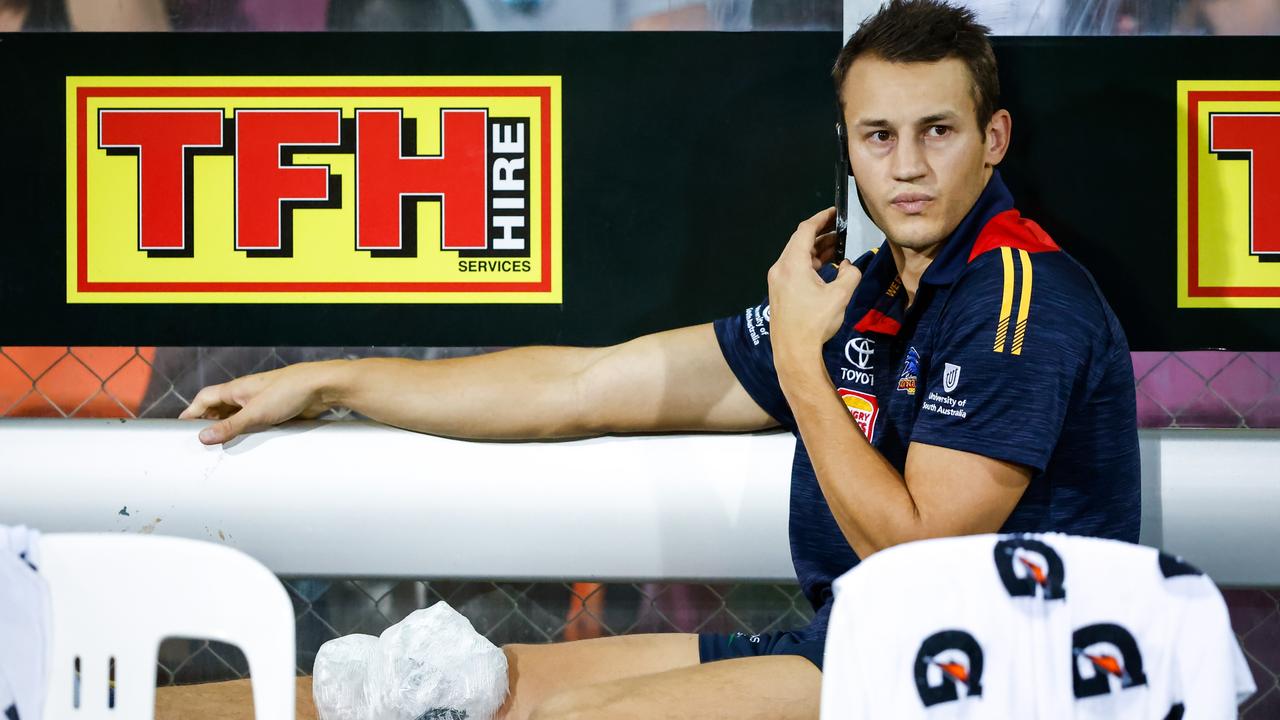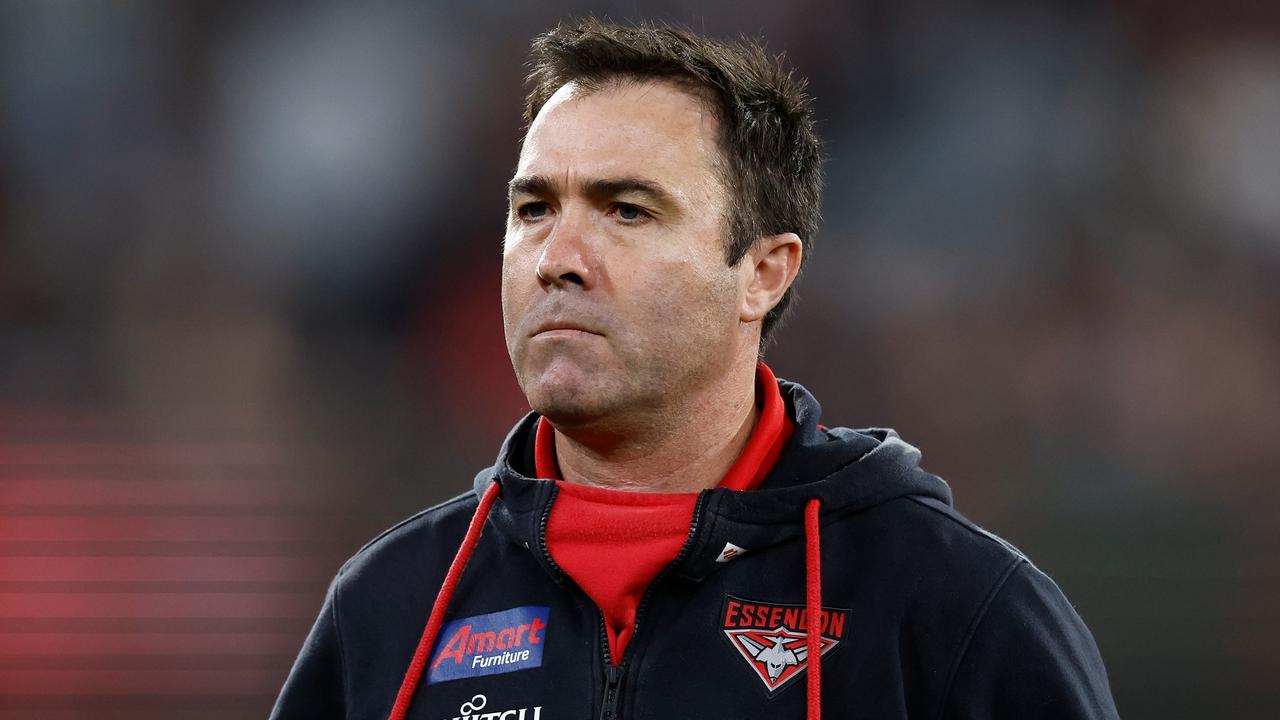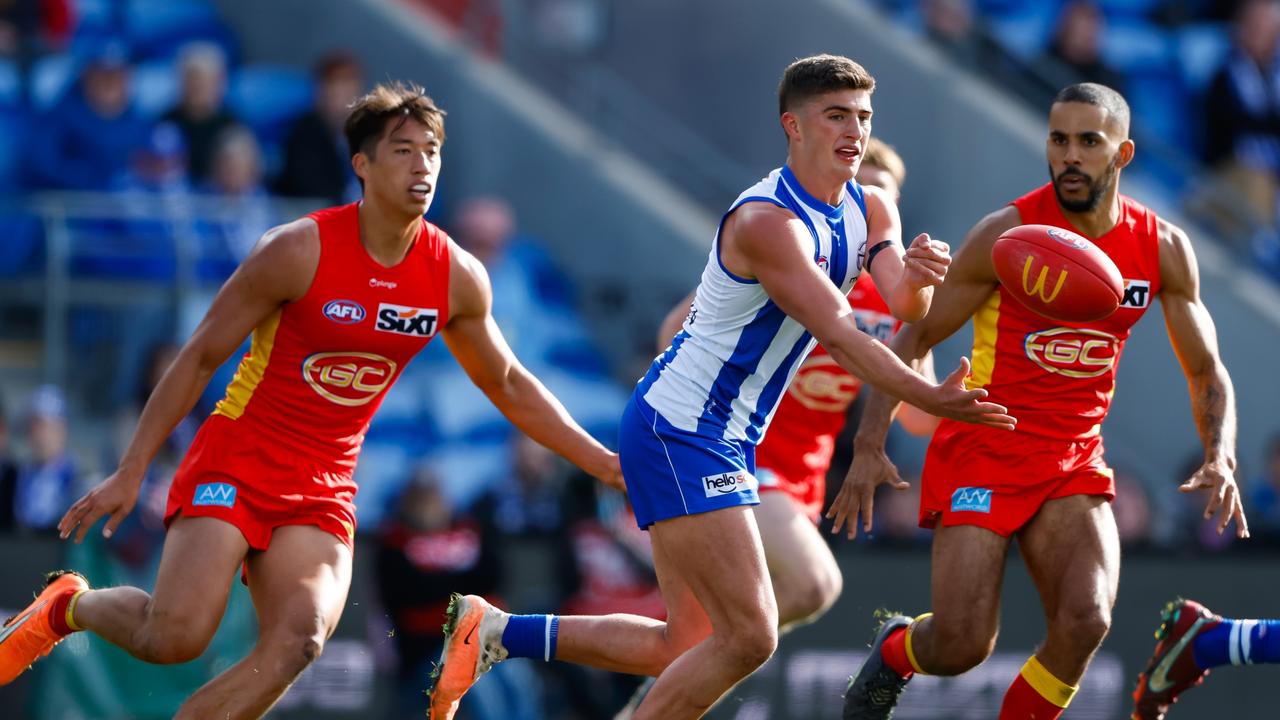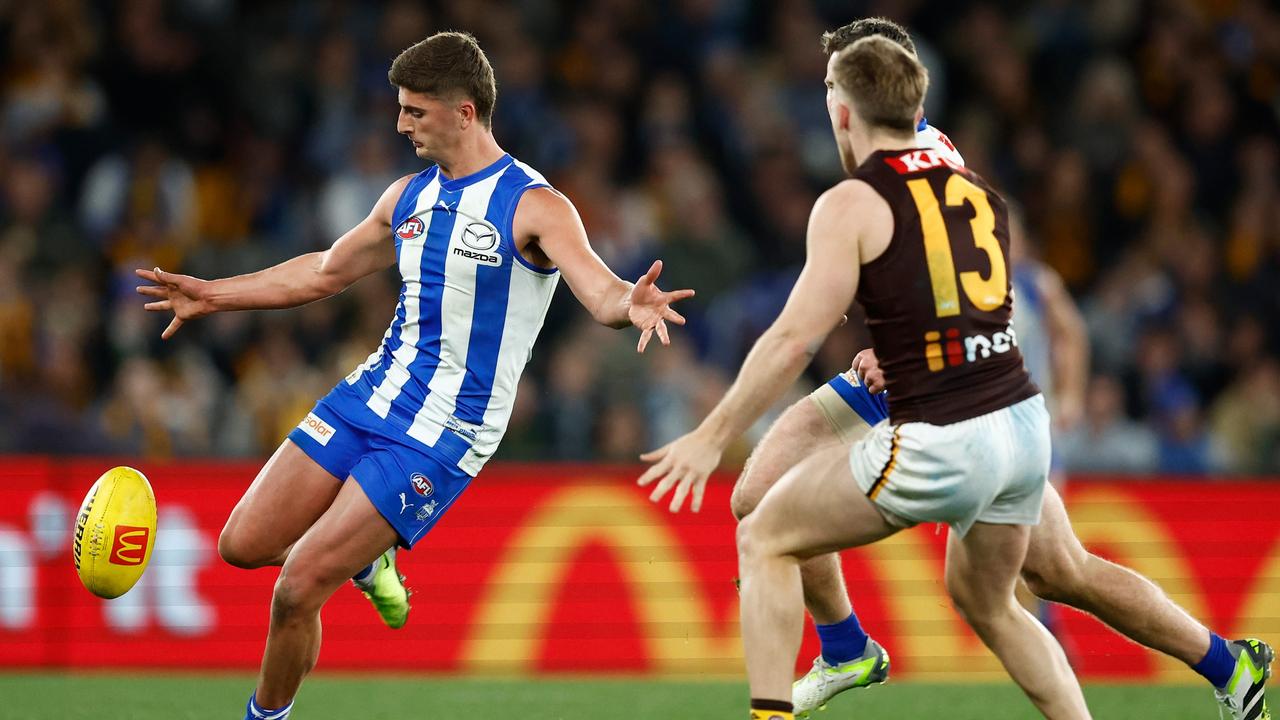Mick McGuane: The good and bad of the non-finals teams and where they can get better in 2024
Harrison Jones, Zach Reid and Nik Cox were meant to help drive Essendon to the next level. Where are they at? Mick McGuane looks at the Bombers and what the high picks must get right.

While eight teams prepare for finals, it has been a week of exit meetings for 10 other clubs as they look towards 2024.
AFL analyst Mick McGuane has taken a look at the 10 teams who finished the year early, what they did well and what they did poorly this year and where they can get better in 2024.
WESTERN BULLDOGS

THE GOOD
The Bulldogs have aligned themselves to a brand of football that reflects teams like Melbourne.
They put a real emphasis on contested possession and clearance wins and gain great territory from those.
With a midfield brigade boasting the pre-eminent ruckman in the competition in Tim English, the Brownlow Medal favourite in Marcus Bontempelli and contested ball winning beast Tom Liberatore, it’s little surprise that the Bulldogs were again strong in these areas this year.
They ranked second in the competition for clearance differential and third for contested possession differential.
However, unlike the Demons, they’re not playing finals because other areas of their game are not up to scratch.
THE BAD
The Bulldogs’ ball movement has been impacted by poor kicking and unforced errors this year, which have contributed to them ranking 15th in the competition for moving the ball from defensive-50 to inside-50.
Bailey Dale and Ed Richards are weapons off halfback who play with an attacking mindset, but skill execution lets them down at times.
The side’s forward line also needs a rejig, after ranking 10th in the competition for turning inside-50s into scores this season.
Beveridge must consider training Aaron Naughton as a defender over summer and playing an extra small in attack alongside Jamarra Ugle-Hagan or whoever is better form between Rory Lobb or Sam Darcy.
Playing too many talls means the frontline pressure from the Bulldogs has been poor and as good as Cody Weightman has been, he needs more help in that area of the ground.
ADELAIDE

THE GOOD
The Crows were an offensive force to be reckoned with this season, who would punish teams from turnover.
They No. 1 in the competition for points for at an average of 95.3 points a game, No. 1 from scores per inside-50 and No. 2 for points from turnovers.
Opposition teams could not afford to cough up the ball to the Crows, because if they did it would come back at speed and precision.
Taylor Walker (76 goals) produced an extraordinary year, while Izak Rankine (36 goals) will only be better with another pre-season under his belt and Darcy Fogarty (34 goals) benefited from greater fitness on the back of a big summer.
They were three of six players to kick over 20 goals, which is a very healthy spread.
Through the midfield, captain Jordan Dawson also elevated his game but needs to improve his scoreboard impact after kicking just 6.15.
THE BAD
The Crows should go to school on St Kilda’s defensive system over the off-season as they seek improvement in that area of their game.
Adelaide ranked ninth for points against this year and 12th for opposition scores per inside-50.
Personnel issues didn’t help that, with the likes of Tom Doedee (11 games), Jordan Butts (17 games) and Nick Murray (17 games) all missing significant footy.
But if the Crows can take some elements of what Ross Lyon has been able to do at the Saints and implement those into their own game to create a balance between their offence and defence, they will be playing finals football next year.
ESSENDON

THE GOOD
Particularly in the first half of the year, the Bombers’ ability to slingshot the footy from their back half and generate scores was exhilarating to watch.
But you can question whether that is a sustainable brand and more so when there is glaring issues with other aspects of their game.
Essendon ranked second in the competition for generating inside-50s from defensive 50 chains this season and ranked fourth from scoring points from their defensive half.
If they can maintain those numbers while fixing some of their problems, improvement will come.
There was disappointment from fans about the late-season fade-out, but the Bombers delivered on expectations for mine.
I didn’t think they would play finals at the start of the season and they aren’t.
THE BAD
I’ve had a constant gripe for some time that too many Essendon players pick and choose when it comes to giving optimal levels of defensive intent.
They Bombers ranked 17th in the competition for pressure applied this season, which has been a common thread across recent years and simply has to improve.
Essendon also gives the ball back to its opposition far too easily at times and defending their own turnovers must be made a key priority over summer.
The side loses its defensive formation too often and that is why they were the fourth-easiest team in the competition to move the ball against this season and were the fifth-most scored against team on turnovers.
The loss of key defender Jordan Ridley in the last five weeks of the season hurt badly and the Bombers must land another big key defender through trade or free agency this year.
They also need to ensure Harrison Jones, Zach Reid and Nik Cox get their bodies right and have big pre-seasons if that trio is to ever deliver on their talent.
GEELONG

THE GOOD
The Cats’ strength remains in their forward line, which is no surprise given the names they have down there.
Jeremy Cameron (53 goals) and Tom Hawkins (49 goals) again led the way, along with newcomer Oliver Henry (41 goals) who had a strong first season at the club.
Smalls Tyson Stengle, Brad Close and Gryan Miers also had significant impact both kicking goals and setting them up.
Geelong’s forward group is a selfless one, have a great understanding of each other and will offer decoy leads to provide space for teammates.
The Cats consequently were the third-most efficient team at scoring once inside-50 this season, while also ranking fifth for points for as well as fifth for points from turnovers.
THE BAD
A touch of complacency might have slipped into the Cats’ mindset after their 2022 premiership, because their contest and clearance game that made them such a great side last season suffered a major drop off.
Geelong ranked 11th for contested possession differential this season, down from fourth in 2022.
It also fell from fifth to 16th when it came to clearance differential.
Giving up territory is not what you want.
Cam Guthrie (six games) was sorely missed through injury, not only for his own ball-winning ability at the coalface but also his organisational skills as a midfield general who directs teammates around stoppages.
Captain Patrick Dangerfield was also missed in critical periods, while experienced ruckmen Rhys Stanley and Jonathon Ceglar missed significant chunks of the season.
The injuries to Stanley and Ceglar did provide an opportunity for Toby Conway in the final round, though, who showed enough to my eyes to suggest he is going to be a very good 10-year player.
With another big pre-season on the track and in the gym, Conway’s upside next year could be huge.
RICHMOND

THE GOOD
The Tigers struggled to get their balance right between offence and defence in the first half of the season, but caretaker coach Andrew McQualter was able to open up the scoring after he took over in round 11.
Under McQualter’s reign, the Tigers ranked No. 1 in the competition for scoring once inside 50 and fifth for points from their forward half.
Those numbers were achieved despite some poor conversion in front of goal at times and key focal point Tom Lynch not being sighted after round 4.
Lynch will be a massive inclusion in 2024, but he will need a new partner in attack after the retirement of Jack Riewoldt.
Ben Miller does not look capable of holding down a key position spot, but I have great faith that Samson Ryan can explode with his game next season and become the perfect foil to Lynch.
THE BAD
The once heralded Tigers’ team defence failed them far too often this season.
However, they weren’t helped by a midfield group that struggled to gain territory.
Richmond at its best has been a team that has one of the highest time in forward half differentials in the competition.
Gaining territory on the back of strong midfield contest wins and locking it in their F50 is Richmond’s way.
This season they ranked 13th for time in forward half, as well as 15th for inside-50 differential.
There needs to be a big emphasis put on improving the front-half profile over the off-season.
Recruits Tim Taranto and Jacob Hopper were supposed to help bolster the midfield, but while Taranto produced a great season Hopper was not up to par.
He needs to get his body right and launch into a big summer in a bid to rediscover the best footy he played at GWS and justify his seven-year deal at Punt Rd.
GOLD COAST

THE GOOD
One big plus for incoming Suns coach Damien Hardwick is the fact that the club used 40 players this season.
That will give him a good line of sight to find out who on the list is capable and who will be able to action how he wants his team to play.
The Suns’ strength was their contest work, where they boast a tough and reliable group consisting of ruckman Jarrod Witts and on-ballers Matt Rowell, Touk Miller and Noah Anderson.
Gold Coast ranked fourth for clearance differential this season and seventh for contested possession differential.
However, maximising those contest wins by putting teammates into space to drive forward is an area of their game that still needs some work.
THE BAD
Days after Hardwick said that 80 per cent of the club’s next premiership list was already at the club, the Suns went out and lost to a North Melbourne side that was on a 20-game losing streak.
Forward half intercepts are a good indicator of how much pressure the forwards are applying and the Suns ranked 14th for forward half intercepts this season and 17th at scoring points from them.
They need to snap into an offensive mindset and understand spatial awareness better than they currently do if they want to generate more scores from turnovers and elevate themselves into a finals team.
With that in mind, it might be time to change the forward structure and move on from Levi Casboult, who doesn’t provide enough when the ball hits the ground.
There is plenty of talent there at the Suns, but Hardwick has a lot of work to do to get the best out of the group.
The Suns are consistently inconsistent.
FREMANTLE

THE GOOD
The Dockers found form in last five weeks of the season, but unfortunately for them it was too late.
If they had have emulated their last five weeks across the year, they would have been playing finals football and be seen as a premiership threat.
The strength of Fremantle’s game is its defence, which was the stingiest in the competition across the past five weeks as it conceded just 60.8 points a game.
That included holding Geelong to 64 points at GMHBA Stadium and keeping top-four sides Brisbane (77 points) and Port Adelaide (74 points) to below-average scores.
In those final five weeks, the Dockers also rated second in the competition for opposition points from turnovers and fourth for restricting opposition ball movement from defensive 50.
That is a profile that coach Justin Longmuir will be looking to build on going into pre-season.
THE BAD
Fremantle needs to take a leaf out of the books of clubs like Geelong and Adelaide and fix its forward line as a matter of priority.
As I tipped at the start of the year, Jye Amiss produced a breakout season as a key forward and made the most of his opportunities to kick 41.17 from 22 matches.
He is going to be a player of the future – but he needs some more help in attack.
The Dockers ranked 14th for points scored this season, 13th for scores per inside-50 and 13th for points from turnovers.
That’s why they finished with a lowly percentage of 96.7 despite their strong defensive profile.
Nat Fyfe’s move forward didn’t work in his limited games, Matt Taberner’s body can’t be trusted and the club’s second-highest goalkicker behind Amiss this year was Michael Walters who is 32.
Significant change is required.
HAWTHORN

THE GOOD
The Hawks are a team that are clearly trending in the right direction under coach Sam Mitchell.
Across this season, they looked to the naked eye to be far more committed to the contest and getting after the ball when it was in dispute and that is reflected in the numbers.
Hawthorn ranked sixth for contested possession differential this year, third for ground ball gets and seventh for clearances.
The likes of Jai Newcombe, James Worpel, Will Day and Dylan Moore were constantly hunting the footy and consequently were getting first access to it more often than not.
Down back, captain James Sicily had a sizzling season and up forward Luke Breust (47 goals) and Mitch Lewis (36 goals) were brilliant.
The Hawks just need to find some greater consistency week-to-week.
Wins over Collingwood and Brisbane in the second half of the season showed they are more than capable when they are on.
THE BAD
Strengthening the bookends would be a firmly in the sights of list manager Mark McKenzie.
The side ranked 16th in both points for and points against this season and is crying out for some more key posts at both ends of the ground.
The Hawks need to find another key forward to support Lewis, but perhaps more importantly they need to find another key defender to support Sicily.
Sam Frost is too shaky and the club’s No. 6 draft pick from 2020 in Denver Grainger-Barrass hasn’t elevated as quickly as Hawthorn would have hoped.
The club should be putting itself right in the race for North Melbourne’s Ben McKay or Geelong’s Esava Ratugolea during the free agency and trade period.
NORTH MELBOURNE

THE GOOD
The big positive for the Kangaroos and new coach Alastair Clarkson this season was that 43 players had an opportunity to strut their stuff at senior level.
Even though it was a testing year and Clarkson needed a break during the middle part of the season to get himself right, he will now have a much greater understanding of the playing list and what the club needs to do moving forward with its rebuild.
Two new players who were exposed to AFL football were Harry Sheezel and George Wardlaw.
Sheezel averaged 27 disposals from his 23 games in a remarkable debut season, while Wardlaw showed across his eight games that he is going to be a player of note for many years to come.
Luke Davies-Uniacke also took his game to another level, despite only playing 14 games due to an unlucky run of injury.
THE BAD
As good as he was this year, North Melbourne was far too reliant on Nick Larkey hitting the scoreboard on a weekly basis.
Larkey finished third in the Coleman Medal race with 71 majors – which was 29.2 per cent of the Kangaroos’ overall goal tally this year.
Having one key forward kick such a high percentage of your score is not healthy.
North Melbourne needs to get Charlie Comben’s body right so he can step up and help Larkey, while Cam Zurhaar is also an important player but only featured in 16 matches due to injury this season.
Tarryn Thomas finished the year strongly after his early-season off-field issues and Clarkson and the Kangaroos need to ensure he builds on that and doesn’t waste his enormous talent.
If North Melbourne loses Ben McKay to free agency, it is going to need to find someone in the trade period to fill a key defensive post next season.
WEST COAST

THE GOOD
There wasn’t a lot that was good about West Coast’s two-win season, but the final few weeks were at least better.
With coach Adam Simpson under siege, the Eagles found something in the final four weeks and lifted their pressure applied ranking from 14th to 7th.
The game is about pressure and if you can’t work both sides of the ball, you’ll allow the opposition to go from back to front and hit the scoreboard more often than not.
So the maturity shown to improve in that area at the tail end of a difficult season was pleasing.
Having greater pressure up the ground also makes the jobs of key defenders like Tom Barrass and Jeremy McGovern a lot easier.
THE BAD
Across the season, the Eagles couldn’t hit the scoreboard, didn’t use the ball well and couldn’t convert their inside-50s into scoring opportunities.
They ranked 18th for points for and 17th for scores per inside-50.
Oscar Allen (53 goals) was a star in a struggling side, but West Coast needs to reinvigorate its front half of the ground around him.
Jack Darling only managed 26 goals from his 20 matches and isn’t getting any younger.
Jamie Cripps and Liam Ryan both missed significant footy this year and are important pieces of the puzzle when fit, so their returns next year should help.
When you’re not a part of finals participation, a sense of feeling “second rate” exists, as all you can do is sit back and watch the other 8 teams go at it for footy’s ultimate prize.
It’s a horrible feeling.
But what it does, it fuels motivation for the future.
For these 10 clubs and it’s players, 2024 can’t come around quick enough.
More Coverage
Originally published as Mick McGuane: The good and bad of the non-finals teams and where they can get better in 2024




